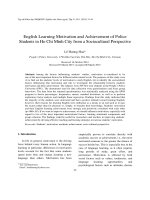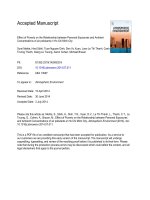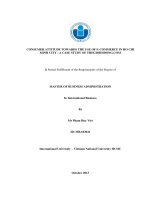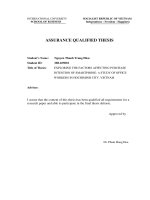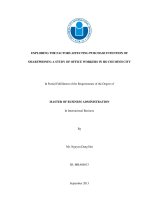Impacts of human resource practices on organizational engagement and turnover intention case of business employees in ho chi minh city
Bạn đang xem bản rút gọn của tài liệu. Xem và tải ngay bản đầy đủ của tài liệu tại đây (1.3 MB, 110 trang )
MINISTRY OF EDUCATION AND TRAINNING
UNIVERSITY OF ECONOMICS HCM CITY
------ ------
TRƯƠNG QUỐC CƯỜNG
IMPACTS OF HUMAN RESOURCE
PRACTICES ON ORGANIZATIONAL
ENGAGEMENT AND TURNOVER INTENTION:
CASE OF BUSINESS EMPLOYEES
IN HO CHI MINH CITY
MASTER OF BUSINESS
ADMINISTRATION THESIS
Ho Chi Minh City – 2019
MINISTRY OF EDUCATION AND TRAINNING
UNIVERSITY OF ECONOMICS HCM CITY
------ ------
TRƯƠNG QUỐC CƯỜNG
IMPACTS OF HUMAN RESOURCE
PRACTICES ON ORGANIZATIONAL
ENGAGEMENT AND TURNOVER INTENTION:
CASE OF BUSINESS EMPLOYEES
IN HO CHI MINH CITY
Major: Business administration (research)
Code: 8340101
MASTER OF BUSINESS
ADMINISTRATION THESIS
SUPERVISOR: Assoc.Prof. Dr. TRẦN THỊ KIM DUNG
Ho Chi Minh City - 2019
ACKNOWLEDGEMENT
I would like to express my deepest gratitude and appreciation to my research
supervisor, Assoc. Prof. Dr. Trần Kim Dung for her valuable ideas, guidance,
suggestions and supports for this thesis.
I would like to thanks all lectures of the MBA class who gave us all
knowledge, guidance during the course. And it was a memory time during the
course studying with MBA class member, together we faced and overcame all
difficulties and finished the course. And I also would like to thanks all my friends
and my colleagues who helped me during conducting survey and data analysis.
Finally, I am grateful to my family for caring, encouraging and supporting
me during my studying till now.
Ho Chi Minh City, March 7th 2019
Truong Quoc Cuong
COMMITMENT
I hereby declare that the thesis with title “Impacts of HR practices on
organizational engagement and turnover intention, case of employees in Hochiminh
City” is my study that was adviced by Assoc. Prof. Dr. Tran Kim Dung.
All information in this thesis has been obtained and presented in concordance
with academic rules and ethical conduct.
I am fully charged of responsibility for all content of this research.
Hochiminh city, March 07th 2019
Truong Quoc Cuong
TABBLE OF CONTENT
COMMITMENT
LIST OF ABBREVIATION
LIST OF TABLES
LIST OF FIGURES
ABSTRACT
CHAPTER 1: INTRODUCTION .............................................................................. 1
1.1. Research background .................................................................................... 1
1.2. Objectives for study ...................................................................................... 5
1.3. Research scope and approach ....................................................................... 5
1.4. Research methodology ................................................................................. 5
1.5. Theoretical and practical significance of study ............................................ 6
1.6. Structure for this study ................................................................................. 7
CHAPTER 2: LITERATURE REVIEW AND RESEARCH MODEL .................... 9
2.1. Concepts definition and concepts measurement............................................ 9
2.1.1. Organizational engagement ..................................................................... 9
2.1.2. Human resource practices (HR practices) ............................................. 15
2.1.3. Turnover and Turnover intention ........................................................... 21
2.2. Relevant researches and relationship of concepts ....................................... 25
2.2.1. Relevant researches................................................................................ 25
2.2.2. The effects of HR practices on turnover intention................................. 27
2.2.3. HR practices and engagement................................................................ 28
2.2.4. Organizational engagement and turnover intention ............................... 31
2.2.5. Mediating role of organizational engagement ....................................... 32
2.3. Hypotheses and research model .................................................................. 33
CHAPTER 3: RESEARCH METHODOLOGY ..................................................... 35
3.1. Method of research ...................................................................................... 35
3.2. Research design and process ....................................................................... 35
3.3. Qualitative research ..................................................................................... 38
3.5. Method of data analysis ............................................................................... 46
CHAPTER 4: RESULT OF DATA ANALYSIS .................................................... 53
4.1. Descriptive data analysis ............................................................................. 53
4.2. Normal distribution examining .................................................................... 54
4.3. Reliability of measurement scales ............................................................... 54
4.4. Explore Factors Analysis ............................................................................. 55
4.5. Confirmatory Factor Analysis (CFA) .......................................................... 57
4.6. Checking hypothesis and research model.................................................... 66
CHAPTER 5: CONCLUSIONS AND IMPLICATIONS ....................................... 71
5.1. Research conclusions ................................................................................... 71
5.2. Research contributions ................................................................................ 73
5.3. Managerial implications .............................................................................. 74
5.4. Limitations and recommendations for further research............................... 74
REFERENCES
APPENDIX
LIST OF ABBREVIATION
Abbreviation
Full word
AVE
Average variance extracted
CM
Career management
CFA
Confirmatory Factor Analysis
CFI
Comparative Fit Index
Chi-sq, 𝜒2
Chi-square
CP
Compensation
CR
Construct reliability
df
Degree of freedom
EFA
Exploratory Factor Analysis
EE
Employee engagement
GFI
Goodness -of Fit Index
HR
Human resource
KMO
Kaiser - Meyer - Olkin
RMSEA
Root Mean Square Error Approximation
SE
Selection
SEM
Structural Equation Model
Sig. (p)
Significance of Testing (p-value)
SET
Social exchange theory
TLI
Tucker and Lewis Index
TI
Turnover intention
LIST OF TABLES
Table 2- 1: Summary researchers about engagement ............................................ 12
Table 2- 2: Components of HR practices ............................................................... 18
Table 3- 1: PA scale ............................................................................................... 40
Table 3- 2: CD scale ............................................................................................... 41
Table 3- 3: SE scale ................................................................................................ 42
Table 3- 4: CP scale ............................................................................................... 43
Table 3- 5: OE scale ............................................................................................... 44
Table 3- 6: TI scale ................................................................................................ 44
Table 3- 7: Sample size .......................................................................................... 45
Table 3- 8: Fit index of CFA .................................................................................. 50
Table 3- 9: Formula of CR, AVE ........................................................................... 51
Table 4- 1: Description of sample .......................................................................... 54
Table 4- 2: Summarized Cronbach Alpha test for all variables ............................. 55
Table 4- 3: EFA result with 4 factors ..................................................................... 56
Table 4- 4: Discriminant validity and construct reliability of HR practices scale . 58
Table 4- 5: Construct reliability of pooled model .................................................. 62
Table 4- 6: Unidimensionalityality of the pooled model ....................................... 62
Table 4- 7: Discriminant validity of pooled model ................................................ 63
Table 4- 8: The relationship of all concepts ........................................................... 67
Table 4- 9: The total effect of HR practices on turnover intention ........................ 68
Table 4- 10: Comparing effect of HR practices on TI, OE .................................... 70
LIST OF FIGURES
Figure 2- 1: Research model of Juhdi et al (2013) ................................................. 25
Figure 2- 2: Research model of Chughtai (2013) .................................................. 26
Figure 2- 3: Proposed research model .................................................................... 34
Figure 3- 1: research process.................................................................................. 37
Figure 4- 1: The CFA construct model of HR practices ........................................ 59
Figure 4- 2: The CFA of pooled measurement model ........................................... 65
Figure 4- 3: the analysis result of research model ................................................. 66
ABSTRACT
The purpose of this study is examining the relationship of HR practices
(Selection, performance appraisal, compensation and career management) with
Organizational engagement (OE) and Turnover intention (TI). Basing on previous
research frameworks, the study still tests the negative impact of both HR practices
and OE on TI. And tests positive impact of HR practices to OE and the mediating
role of OE in relationship of HR practices and TI.
The survey was conducted with total 405 employees who are working as
staff in various sectors in Ho Chi Minh City and studying at UEH. The data was
collected by mainly face to face survey; then it was analyzed using SPSS and
AMOS software. The results were found that: all the adjusted, developed variables
scales used to measure HR practices, OE and TI met the criteria of liability and
fitness validity; HR practices with 4 componentes had significant effect on OE and
TI. PA had strongest effect on OE (β=0.334) while SE had weakest effect on OE
(β=0.083). Each component of HR practices had its own effect on TI. SE had
strongest negative effect on TI (β=-0.454) and CM had weakest negative effect on
TI (β=-0.017). OE had important role to predict TI (β=-0.424). The result proved
that OE played mediator in relationship between HR practices and TI.
The study also discussed and proposed about contributions, limitations and
managerial implications.
Key words: HR practices, Organizational engagement, Turnover intention,
employees.
TÓM TẮT
Mục đích của bài nghiên cứu này nhằm khảo sát sự mối quan hệ của thực tiễn
nguồn nhân lực (HR practices) (4 thành phần là tuyển chọn (SE), đánh giá thành
tích (PA), phát triển nghề nghiệp (CM) và trả công lao động (CP)) với gắn kết tổ
chức (OE) và ý định nghỉ việc (TI) của nhân viên văn phòng. Dựa vào các nghiên
cứu trước đây, bài nghiên cứu này sẽ khảo sát sự tác động âm của thực tiễn nguồn
nhân lực cùng gắn kết tổ chức đến ý định nghỉ việc. Đồng thời bài nghiên cứu cũng
kiểm tra tác động dương của thực tiễn nguồn nhân lực đến gắn kết tổ chức; và kiểm
tra sự tác động của thực tiễn nguồn nhân lực đến ý định nghỉ việc qua trung gian là
gắn kết tổ chức.
Bài nghiên cứu được thực hiện bằng phương pháp chọn mẫu thuận tiện thông
qua chủ yếu khảo sát trực tiếp 405 đáp viên là nhân viên văn phòng thuộc nhiều lĩnh
vực trong thành phố Hồ Chí Minh và đang học tại UEH. Dữ liệu được phân tích
bằng phần mềm SPSS và AMOS. Kết quả cho thấy tất cả các thang đo đều đáp ứng
các tiêu chuẩn giá trị và độ tin cậy cho phân tích. 4 thành phần của HR practices có
tác động lên OE và TI. Trong đó, PA (β=0.334) tác động mạnh nhất và SE
(β=0.083) tác động yếu nhất lên OE. Và SE tác động mạnh nhất (β=-0.454) và CM
tác động yếu nhất (β=-0.017) lên TI. OE tác động mạnh đến TI (β=-0.424). Kết quả
cũng minh chứng vai trò trung gian của OE.
Bài nghiên cứu cũng đưa ra thảo luận kết quả và đưa ra những đánh giá về
đóng góp, giới hạn của nghiên cứu và những hàm ý quản trị.
Key words: HR practices, Organizational engagement, Turnover intention,
employees.
1
CHAPTER 1: INTRODUCTION
1.1.
Research background
Human capital is one of the hottest topics in Vietnam and gets more attention
in context that we want to keep up with the fourth industrial revolution or called
new economic 4.0. Quality and productive labor is the most important to get
development and attraction investment. Furthermore, human resource is a part of
companies’s strategy to get competitive advantage and effectieness. Its role is
explained by the resource based view theory (RBV) (Armstrong and Taylor, 2014,
p7). RBV states that competitive advantage can be achieved if a firm’s resource is
valuable, rare and costly to imitate. And human resource becomes significance
because it can meet these criteria due to its distinctiveness (Chughtai, 2013). The
organizations always make them efforts to find, develop and retain valuable
workforce who are talent and skilled employees that are precious resources to afford
competitive advantages. Talent staff retainment has become more important than it
used to be, and it became among most concerns of organization strategies about
competitive advantages and organizational effectiveness with the best resources
(Juhdi et al, 2013).
However, organizations have suffered the problems that they loss their welldeveloped employees leaving for other organizations, especially their competitors.
Losing talent employees will lead to reduce in quality, productivity and
effectiveness of each department or all organization that affect to organization’s
competitive advantage. So, huge investment in training and developing human
resource would be in vain if the employees leave and bring along their skills and
experience for other organizations. To counter this problem, employers are trying
coming up organizational talent management programs and retaining employees by
dealing with how to engage trained and highly experienced employees and reduce
employee turnover. The broad range of employee turnover studies (Ma et al, 2016;
2
Long and Perumal, 2014; Kim et al, 2014; Juhdi et al, 2013…) have shown that
turnover is considered as the most popular researched phenomena in organizational
behavior and indicated the significance and complexity of the issue impacting by its
all dimensions (psychological, organizational significance and economic). They
indicate that there are many major variables that impact on the turnover of
employees and use turnover intention as an important predict for actual behavior of
turnover. Moreover, employee engagement is considered as a significant factors
impacting to reduce turnover intention of employees. By making employee more
engaged to organization, employers can be not only continue to get effectiveness of
developing employees programs but also to get the results of retaining skilled and
experienced staffs. So, the concerns of organization are paid more attention into
increasing engagement level of employee.
It is to say that HRM system is considered as play significant role to
increasing engagemenet level and decreasing turnover intention of emplyees.
Human resource management are the policies and procedure involving HRM
aspects of management regarding, planning, recruitment, selection, training and
management, performance appraisal and labor relations (Dessler, 2006, cited from
Armstrong and Ttaylor, 2014). Some researchers (Juhdi et al, 2013; Chughtai, 2013)
suggested that HR practices should consider as good antecedents of employee
engagement and turnover intention. HR practices are more important because they
exist and effect on daily operatations of organization in shaping employee’s
attitude, cognition and behavior. The HR practices concept is not a new one. In 5-P
model of Schuler (1992), there are 5P in strategy HRM and HR practices include
activities that carry out in implement HR policies and programs. Armstrong and
Ttaylor (2014; p9) stated that HRM can be seen in a system that incorporated with:
HR strategies, HR policies and HR practices-“which consist of the HRM activities
involved in managing and developing people and in managing the employment
relationship”.
HR practices can help organizations enhance their performance,
decrease absenteeism and turnover. Researchers explain HR practices role that it
3
could impact on employee perception that the creation of a safety climate,
motivation, meaningfulness, emotion... According to Robbins and Judge (2010),
human resource (HR) practices are one of the factors in the organization that could
shape and determine employee responses at work. HR practices can help for
explaining how these practices influence employee engagement and turnover
intention.
So, examining the relationship of HR practices with employee engagement
and turnover intention is necessary. By searching on Proquest, EBSCO for studies
about three concepts relationship, author just found out some results.
Results of searching on Proquest, EBSCO:
Key words for searching
Proquest
EBSCO
105 results
498 results
227 results
1,217 results
8 results
27 results
1 result
1 result
Studies with abstract of:
Human resource practices
Turnover intention
Studies with abstract of:
Engagement
Turnover intention
Studies with abstract:
Human resource practices
Organizational engagement
Turnover intention
The relationship of HR practices,
organizational engagement, turnover
intention
Source: author searching
After searching Proquest, EBSCO from Library of University of Economics of
Ho Chi Minh City, there is no any title research about impacts HR practices on
organizational engagement, turnover intention in Ho Chi Minh City. So, this
research is necessary for study.
4
From various researches, HR practices have been called with different labels
and components. But the basic components of HR practices which are applied in
almost organizations will always be career management, performance appraisal,
selection and recruitment, compensation and benefit management; and these
components are easy to strongly effect on individuals, enhancing engagement and
dereasing turnover intention (Juhdi et al, 2013). So, this study prefers to use basic
function of HR practices (selection, career management, compensation and
performance appraisal) in choosing the factors in the independent variable that
hoping they will well explain to dependent variables (engagement and turnoer
intention)
But employee engagement is multidimension concept. Employee engagement
is not a new concept but it is to say that engagement is also a term that is got more
attention and researches. There are many studies research about it with mixing the
meaning, dimension and facet approach. Engagement can be easy to misunderstand
by many divided concepts into engagement, work engagement, job engagement and
organizational engagement. But these are different because of dimensions of
engagement that researchers want to study employee engagement in specific
aspects. In general, these are engagement of employee and there are 4 approaches of
engagement as Saks and Gruman (2014), Shuck et al (2011) argued that they are
need-satisfying, burnout-antithesis engagement, satisfaction and mixed engagement
approach. As Saks (2008) stated about mixed engagement approach that its
components (job engagement and organizational engagement) would explain better
than other approachs. However, Saks (2006) studied about engagement’s
antecedents, HR practices weren’t addressed. As Juhdi et al (2013) agreed with
Saks (2006) about mixed engagement approach, but just organizational engagement
is used as onsequence of HR practices. And Juhdi et al (20013) suggested and
proven that HR practices have strong effect on organizational engagement.
As some studies use engagement to explain the relationship of HR practices
and turnover intention (Juhdi et al, 2013; Chughtai, 2013…) and the results
5
supported very clearly about the mediator of employee engagement. As Saks (2006)
suggest that using employee engagement with social exchange theory could help
clearly explaining the relationship of engagement with its antecedents and
consequences. So, this study also hope that using the engagement with Saks (2006)
measurement scales as a mediator will have supportive results for the impact of HR
practices on turnover intention.
From above premises, this study suggests the title research is that: “Impacts of
HR practices on organizational engagement and turnover intention, case of business
employees in HCM City”.
1.2. Objectives for study
This study aims to three goals, they are:
Firstly, it is checking the impact of HR practices to turnover intention;
Secondly, it is examining the relationship of HR practices and organizational
engagement;
Thirdly, it is testing the effect of organization engagement on turnover
intention;
Lastly, the thesis is checking the mediator role of organizational engagement
in relationship of HR practices and turnover intention.
1.3.
Research scope and approach
As mention in the beginning, this research aims to explain clearly the situation
of the skilled and talent employees leaving their organization for others. So, we
choose business employees who have university degree in various business fields to
investigate. The research samples are working for companies as office staff with
more than 6 months experience in their position. They have age over 22 years old
and they are studying for second university degree, evening course university
degree and master degree.
6
This study chooses Ho Chi Minh City because it is the biggest city in Vietnam
and has immense skilled labor.
By limit of resource and time, we just use convenient choosing sample method
by using data form attenders in University of Economic in HCM City for second
degree and master degree who are working for organization as officer.
1.4.
Research methodology
This study uses both 2 method of research: qualitative research and
quantitative research.
Qualitative research is conducted with 10 employees working as staff in arious
companies in order to explore, adjust and develop measurement scale of research
concepts.
Quantitative research is implimentated with questionnaire with the sample size
is 450 respondents working as employees in office departments of various
companies in HCM city. Convinience method is used. To testing measurement scale
and theorical model, data is analyzed with EFA, CFA ans SEM. This study uses
SPSS 23 and Amos 20 to analyze data.
1.5.
Theoretical and practical significance of study
About theoretical aspect, this study will examine the relationship of HR
practices, organizational engagement and turnover intention of employee in context
of Hochiminh City, Vietnam. This study also provides adjusted and developed
measurement scales of concepts (HR practices, organizational, turnover intention)
to use for employees.
About practical aspect, this study will provide more information about the
relationship of HR practices, organizational engagement and turnover intention of
employee. Basing on model research, it can help organizational managers out of
high turnover rate by using the mechanism of HR practices. Employers should pay
7
attention to improve factors of HR practices in order to enhance organizational
engagement and reduce turnover intention of employees.
1.6.
Structure for this study
This study contains 5 chapters, including of: introduction, literature review,
research methodology, data analysis and conclusion. Specifically:
Chapter 1: Introduction
This chapter introduces about the essence of this study in practice and theory,
the main achieving goals of this study: Examing impacts of human resource
practices on organizational engagement and turnover intention, case of employees
in HCM city.
Chapter 2: Literature review and research model
In this chapter, author explains all theoretical concepts in this study, they are:
HR practices and its components, organizational engagement and its measurement,
turnover intention; then explaining theory used in this study and proving the
relationship of these variables. Finally, theoretical hypotheses and research model
are discussed.
Chapter 3: Research methodology
This chapter describes the method to conduct the study including the
research design, measurement scale building and process of research survey. The
method to analyze collected data and standard analysis are also presented in this
chapter.
Chapter 4: Results and data analysis
In this chapter, all collected data are analyzed by using SPSS, Amos software
to examine all hypotheses and the research model. Depending on analysis results,
the relationship of all factors as mentioned in this research will be examined.
Chapter 5: Discussion, limitation and implementation
8
In this chapter, author will summary results and give practical meanings and
advices for implement as well as theoretical attributions and limits of research and
suggestions for future research.
9
CHAPTER 2: LITERATURE REVIEW AND RESEARCH MODEL
Chapter 2 consists of 4 sections. The first section presents all theoretical
concepts including of organizational engagement, human resource practices,
turnover intention and their role and measurement. The next section presents
relevant researches and theoretical concepts relationship. The last one suggests
hypotheses and research model.
2.1. Concepts definition and concepts measurement
2.1.1. Organizational engagement
2.1.1.1. Concept of organizational engagement (OE)
Employee engagement
Employee engagement is a concept that has gained popularity for a long
period in both academic researchers and practitioners (Malash and Jackson, 1997;
Schaufeli and Bakker, 2004; May, Gilson and Harter, 2004; Saks, 2006; Macey and
Schneider, 2008; Shuck and Wollard, 2010; Chughtai, 2013; Juhdi, 2013…).
Especially in today, employee engagement is a top topic in human resource
management and it is considered with associating with positive and desirable
outcomes in organization. But with its important role, employee engagement is a
widely understood and implemented as well as various approaches and dimensions,
but there are 4 main approaches that researchers paid most attention, they are: needsatifying, burnout-antithesis, satisfaction and mixed approach (Saks and Gruman,
2014)
The first approach is need-satisfying engagement. This concept of engagement
was first time mentioned by Kahn (Armstrong and Ttaylor, 2014). In his researches,
engagement of employees was defined that
“The harnessing of organization members’ selves to their work roles; in
engagement, people employ and express themselves physically, cognitively, and
10
emotionally during role performances”. (Kahn, 1990, as cited from Saks and
Gruman, 2014, 157p)
And engaged employees mean that they themselves bring and display all their
aspects and their full-self to the performance of their roles. In this definition,
employee engagement was defined in the relationship between individual of
employee and his/her roles and tasks in order to focus on performance. As Rich et al
(2010) argued about engagement definition of Kahn (1990) that what engagement
prefers to one-self in role that involves employees invest individually to complete
and get the full self into their role performance. We could consider definition of
Kahn (1990) above as the first approach of engagement what is about psychological
and cognitive dimension or need-satisfying approach (Shuck, 2010). In that,
engagement is a multidimensional construct where employees can be psychological
safety, psychologically available (or availability) and cognitively psychological
engaged (or meaningfulness).
The second one is about burnout- antithesis approach. And there are various
researches (Maslach and Jackson, 1997; Maslach et al, 2001, Macey and Schneider,
2008; Schaufeli and Bakker, 2004…) argued and defined about engagement as a big
engagement approach or called as emotional dimension.
Maslach and Jackson (1997) argued that engagement is relative to energetic,
involvement and efficacy in their job. And based on the literature on burnout,
Maslach et al (2001) defined engagement by opposite of burnout. As Maslach and
Leiter (2008, 498p) defined engaged employees that is:
“An energetic state of involvement with personally fulfilling activities that
enhance one’s sense of professional efficacy”
Engaged employees will feel emotional, involved and energetic to have ability
to finish their task .Scholars study about the engagement such as Gilson and Harter
(2004), Macey and Schneider (2008), also debate that employee engaged in their
task will have a higher level of energy, enthusiasm with their work and loyalty to
their job from day to day. Schaufeli and Bakker (2004) also had definition about
engagement. It’s the psychological status which is relative with work positively and
11
satisfactorily. It has characteristics with three levels: vigor, dedication and
absorption. They explained that vigor (the opposite pole of exhaustion) is a level of
high energetic status, ready for efforts in their task consistently, stably to face
difficult. Dedication (the opposite pole of cynicism) is higher level than vigor. It
present the closed relationship between private task and important emotion and
enthusiasm, feeling deserved for their position and motivation. And the highest
level is about absorption. It shows that the completely satisfaction on their work,
present their concentration to task, spare time, cognate and enjoy their feeling with
their tasks and detaching themselves from work. Robinson et al. (2004) define
engagement as “a positive attitude held by the employee towards the organization
and its values” and state that “an engaged employee is aware of business context,
and works with colleagues to improve performance within the job for the benefit of
the organization”
The third approach, it is about behavioral dimension (or the physical
manifestation of engagement), and Shuck (2011) called this perspective is
satisfaction- engagement approach. In this approach, Harter et al (2002) defined
employees engagement was as their involvement and satisfaction with their job.
Engagement of employee is the tangible, overt manifestation of cognitive and
emotional engagement (Shuck et al, 2011). For many researches, behavioral or
physical engagement (Rich et al., 2010) is understood as the intention of increased
levels of actual performance.
In this approach, a model was proposed that Job demands- resources (JD-R
model) and they are involved to engagement of employees (Saks, 2008). Job
demands is relevant all physical, psychological, social, or organizational
requirement of a job and job resource is about physical, psychological, social, or
organizational function of a job in order to help them get the goals. When job
demands require low and employees are supplied enough necessary job resources to
have good performance as their roles and tasks, they will become more engaged
employees.
12
And the fourth and last approach is mixed three approaches for a new
component. Saks (2006) was considered as the first fully establishing this
perspective. This definition was inclusive of previous literature suggesting that
employee engagement was developed from cognitive, emotional, and behavioral
factors; one is left wondering which of the three should be measured and be focused
of future research (Saks, 2006). It was developed from cognitive element (Kahn,
1990), emotional element with their energy to contribute to organization
performance (Maslach et al, 2001; Schaufeli and Bakker, 2004; Robinson et al,
2004…) and from behavioral component (Rich et al, 2010; Harter et al, 2002…).
Shuck and Wollard (2010) recently defined the term employee engagementas
“an individual employee’s cognitive, emotional, and behavioral state directed
toward desired organizational outcomes”.
Table 2- 1: Summary researchers about EE
No. Researchers
1
2
3
4
5
6
7
8
9
10
11
12
13
14
Cognitive Emotional Behavior
approach approach approach
Kahn (1990)
x
May, Gilson and Harter
x
(2004)
Shuck et al (2011)
x
Maslach and Jackson (1997)
x
Maslach et al (2001)
x
Schaufeli
and
Bakker
x
(2004)
Macey
and
Schneider
x
(2008)
Robinson et el (2004)
x
Harter et el (2002)
x
Shuck (2011)
x
x
x
Rich et al (2010)
x
Saks (2006), Saks (2008)
Saks and Gruman (2014)
x
x
x
Shuck and Wolland (2010)
Mixed
approach
x
x
x
x
x
(Source: Author summarizes)
Organizational engagement
13
This study agrees with the definition of Saks (2006) that employee
engagement is a multi-dimension concept. It is consider with vary roles of employee
and 2 components are concerned that job engagement and organization engagement.
As Saks (2006) defined that engagement shouldn’t consider as an one’s work
situation what encompassing aspects of one’s tasks, work/job, and organization, that
means they don’t engage not only their in-role at work but also outside at work.
Engagement is likely to change from role to role, so mentioning about engagement
should vary his/her roles that they are related organization (Saks, 2008).
In Saks (2006, 604p), he definited about organizational engagement that:
Organizational engagement reflects the extent to which an individual is
psychologically present as a member of an organization.
As Juhdi et al (2013) argued about organizational engagement that it is a
desire to become as a member of organization and willing to conform organization
values and norms. They also make their effort for organization to get good
performance.
And Juhdi et al (2013) suggested that HR practices have strong influence to
organizational engagement. Organizational engagement is an important outcome of
HR practices.
2.1.1.2. The important role of organizational engagement
These are various studies confirming that organizational engagement play an
important in organization. Scholars (Saks, 2006; Albretch et al, 2015; Rich et al,
2010; Juhdi, 2013; Chughtai, 2014…) have also be proven the relationship between
engagement and important individual and organizational outcomes, eventually,
competitive advantage of organization.
Engagement with individual outcomes
Engagement is direct link to individual outcomes. Specificly, employee
engagement impact to his/her outcomes throught effect on employee’s attitudes,
intentions, cognitive and behaviors, for instance, job and organization engagement
14
are significantly positively effect to job satisfaction, organizational commitment,
and organizational citizenship behavior, and negatively impact to intention to quit
(Saks, 2006). As Rich, Lepine and Crawford (2010) proved that employees with
highly engaged level have a good personal performance and have passion for their
work, feel a deep connection to their company. On the contrary, employees with
lowly engaged level have essentially checked out- putting time or absenteeism and
don’t put energy or attention to their work.
Explaining for individual outcomes, Rich et al (2010) speculated that
engaged employees have more energy including psychological, emotional energy to
invest resources, efforts and behaviors to their role and tasks. So, they have good
performance and effective results.
Engagement with organizational outcomes
Engaged employees not only get the high individual performance but also
contribute to business outcomes. According to Harter, Schmidt and Hayes (2002)
engagement and business outcomes have positive relationship. These organizations
whose employees had higher engagement level were more productive, more
profitable than other organizations. Rich, Lepine and Crawford (2010) indicated
that the collective value behaviors of engaged employees would create good job
performance, then it would directly and indirectly contribute to the organizational
goals, and business outcomes. Rich et al (2010) have shown that engagement is
associated with individual employee task and extra‐role performance then it
effected to business performance.
2.1.1.3. Measurement of organizational engagement
There are various measurements of engagement, such as Kahn (1990) first
defined the engagement concept, then May, Gilson and Harter (2004) tested the 3
dimensions of need-satisfying engagement approach. Maslach et al (1997)
developed a burnout- antithesis approach of engagement scale, called the Maslach
Burnout Inventory (MBI) or Schaufeli and Bakker (2004) proposed the Utrecht
Work Engagement scale to measure engagement as vigor, dedication and





